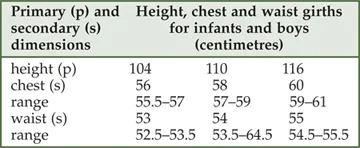![]()
Chapter 1
The basic principles – sizing – using the blocks
Metric sizing and size charts
Size designation and the Centilong system
Size charts are based on body measurements, and are constructed to allow manufacturers to grade sizes efficiently and retail customers to be able to identify clothes to fit a body size.
The British Standards Institution, as early as 1982 (BS 3728), tried to encourage manufacturers and retailers to designate sizing for children by height in centimetres (Centilong system). This Centilong system was the base for the British Standard (BS 7231), published in 1990. It issued a specification for the size designation for children's wear and body measurement size charts to be used by children's clothing manufacturers. Loughborough University undertook the large sizing survey. The adoption of three European Standards (BS EN13402 1–3: 2000– 2004) has reinforced the use of the system in the UK.
Although the Standards are voluntary, most manufacturers and retailers have now accepted the grading and labelling of sizes by height, particularly for those children under twelve. Very few retailers now use age only on their labels, but many add age as extra descriptive information. However, some retailers see height designation as less useful for older girls and boys where the correlation of girth and limb length to height becomes more variable. For this group these retailers mark the garments with chest or bust, waist, hip and inside leg measurements.
Using height as the main control measurement is also considered to be a problem for the increasing proportion of overweight and obese children who find sleeve lengths and trouser lengths of garments far too long for them.
The Centilong system
The Centilong system designates the different sizes of children by 6cm height intervals, i.e. 98cm, 104cm, 110cm, which roughly correspond with age intervals. The fixed points are mid-way in a size range.
Example: the range for the 110cm size label will be from 107cm to 112.9cm height. A child who is 108.5cm in height will be seen as a size 110cm.
British Standards publications on sizing
BS 7231–1: 1990 Body measurements of boys and girls from birth up to 16.9 years. Information in the form of data.
Part 1 contains raw data from the Loughborough University survey shown in centile tables.
BS 7231–1: 1990 Body measurements of boys and girls from birth up to 16.9 years. Recommendations of body dimensions for children.
Part 2 contains size charts of body measurements that were commissioned by the technical committee.
The British Standard BS EN 13402–1: 2000 Size designation of clothes. Terms, definitions and body measurement procedures.
The Standard illustrates methods of taking body measurements and the positions on the body where measurements should be taken.
The British Standard BS EN 13402–2: 2002 Size designation of clothes. Primary and secondary dimension in garments.
The Standard identifies height as the primary dimension on labels for children's clothes and suggests the secondary dimensions that could be used to identify the size of the garment.
The British Standard BS EN 13402–3: 2004 Standard size designation systems for clothing.
The standard designates the size intervals and a secondary measurement range to attribute to the size. Example:
Labelling – size designation
Basic information
The basic control dimension of most infants' and children's garments is the primary dimension of height, based on 6cm intervals. Secondary dimensions add additional information.
Primary dimension ‘Those body measurements, in centimetres, that shall be used to designate the size of the garment for the consumer’ (BS13402-2).
Secondary dimension ‘Those body measurements, in centimetres, that may additionally be used to designate the size of the garment for the consumer’ (BS13402-2).
Examples of these are: chest girth for jackets, waist girth for trousers or skirts, and neck girth for shirts.
The Standards also recommended the use of a pictogram; a diagram of a figure with body measurements indicated. However, no UK companies appear to use one.
Other additional information
Weight The difficulty of measuring babies' height is recognised. Mothers are more likely to know the weight of their baby rather than their height.
Approximate weight is therefore seen as valuable additional information.
Age It is recognised that age alone is an unreliable guide to fit, as children's stature in relation to age is very variable. However, approximate age in addition to height is seen as useful additional information. Some companies are using alternate sizing (12cm) intervals and labelling clothes as 7–8 years but using the measurements attributed to larger sizes.
Garment measurements These should not be used on garment labels as they can be confusing. However, extra information, listed in mail order catalogues or on the internet, such as dress or skirt lengths, can be useful for customers.
The size charts published in this book
The historical background
In 1982, when this book was first written, it was realised that the British Standards Institution's survey, undertaken by the University of Loughborough, was going to take some years. Therefore. the author undertook a smaller scale survey (see Appendix 1). The size charts offered in this book are based on this personal survey. The Standard (BS 7231) was published in 1990. But whilst the raw data in Part 1 has been very valuable to many companies, the interpreted size charts offered in Part 2 have been criticised (see Appendix 1) for anomalies, contradictions and some distorted measurements that are not suitable for cutting patterns. Therefore, the author decided to retain her own size charts in the main body of the book. She found that a great deal of the raw data collected in Part 1 of the Loughborough survey correlated closely with the data collected in her survey and some supple...

